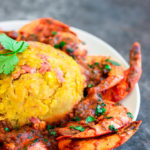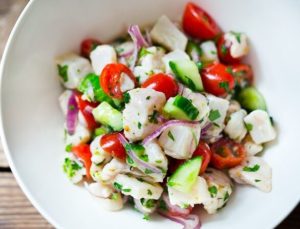Instructor and Registered Dietician Nutritionist, Alicia Romano, dives into traditional food and dishes from Latinx countries.
From Mexico to the tip of South America, Latinx cuisine embodies the traditions of its people and their ancestors. The rich and diverse food culture has developed over centuries and is influenced by varying climates of different geographical regions, unique agriculture, native crops, and global influences – shaping the flavor profiles and traditional dishes of each region. Let’s take a look at different regions and explore the history of their unique cuisines.
MEXICO
Modern-day Mexican cuisine is shaped by varying climates of different regions as well as influence from Spanish and Mediterranean culinary traditions brought over during colonization. Native crops include chili peppers, black beans, tomatoes, squash and corn while cattle, pigs, and livestock. Flavoring agents such as onions, garlic, and spices were introduced when the Spanish arrived in Mexico. This influence can be seen in dishes like Huachinango a la Veracruzana, or Veracruz-Style Red Snapper, which combines both the cooking techniques and flavors of the Spanish and pre-colonial Mexico. The fish is marinated in lime juice, salt, pepper, nutmeg and garlic before being pan fried and then baked with a sauce of tomatoes, oregano, capers, olives, raisins, jalapeños, more garlic, and onions.
In addition to outside influences, the cuisines within the various regions of Mexico have developed independently based on ingredients available to them. For example, the Gulf Coast and Pacific Coast regions rely heavily on fish and other seafood-based dishes. In addition to the original staples, Mexican cuisine includes a mixture of Old World and New World foods like wheat, avocados, pineapples, hearts of palm, mangoes, papayas, radishes, cabbage, cactus, fava and pinto beans, epazote, cilantro, amaranth, and potatoes.
CARIBBEAN
Like other Latin American countries, the Hispanic Caribbean countries rely on corn, starchy vegetables, and beans to form the base of their diet. Plantains are one of the most important ingredients and accompanies many dishes. Many native crops are still used in modern cuisine today such as corn, yams, yucca, peanuts, guavas, pineapple, black-eyed peas, and lima beans.
Different countries have variations of similar dishes, like the African-inspired plantain mash called mango in the Dominican Republic, fufu in Cuba, and mofongo in Puerto Rico. Sofrito is a puree of tomatoes, cilantro, parsley, pepper, onion and garlic and is used as a base for many Hispanic-Carribian stews and sauces. The indigenous people of the area, The Taino, are thought to have been the inventors of barbecue. Barbara, as it is called in Hispanic countries, is the process of slow-cooking meat over a fire, which has evolved into the modern day BBQ.
CENTRAL AMERICA
The location of Central America, between North American and South America, and it’s proximity to the Caribbean, as well as the European influence from 300 years of Spanish rule, has resulted in the region having a rich cuisine similar to other Latin American countries, but unique to the region. The combination of warm weather and fertile land creates rich soil to grow many different crops (fruits and vegetables). Central American cuisine is different from other areas of Latin America in that it does not use chili peppers and therefore the food is less spicy. Guatemala is an exception to this, as chili peppers are important to their regional cuisine.
Corn, or maize, was and remains one of the most important ingredients in a Central America diet. It is commonly ground and treated with lime to make what’s called masa harina. Themasa harina is then used to make tortillas, pupusas (a thick tortilla filled with meat, cheese, and beans), empanadas (a stuffed pastry that is baked or fried), and tamales (masa harina and other fillings wrapped in corn husks and steamed). It is also commonly stirred into stews as a thickener. In some parts of Central America, yuca is used to make tortillas. Beans and rice are another staple, similar to many Latin American countries. Gallo Pinto, a mixture of rice and beans is often served at every meal. It is the national dish of both Nicaragua and Costa Rica.
SOUTH AMERICA
The Spanish and Portuguese colonization of South America in the 16th century shaped the culinary history of the continent. European influences mixed with Indigenous cultures and created a cuisine built on Old World staples of corn, potatoes, manioc (or yuca), and beans and embellished by the European influences of meat, especially beef, wheat, a variety of fresh vegetables and exotic fruit.
The long coastlines also mean a lot of fresh seafood, which makes up one of the most popular South American dishes: ceviche. This dish uses the fresh seafood native to South America, as well as traditional preservation methods – citrus juice of the fruits brought over by Europeans.
The popular dishes vary from country to country depending on climate and geography, but many dishes are popular throughout the continent including empanadas, asado (barbequed meat), and pasta. Another popular tradition is the use of sauces to flavor dishes. Chimichurri is a fresh sauce made from parsley, olive oil, vinegar, and oregano. It is especially popular in Argentina and Uruguay, where they vary slightly in ingredients, but the freshness and tastiness stay constant. It is typically used to accompany grilled meats, but it’s a universal sauce that can be added to pretty much anything!
Other Traditional Staples Across South America:
- Grains: Indigenous grains like quinoa and amaranth, as well as grains brought by the Europeans such as oats, barley, rice and wheat
- Tubers: Yuca (or manioc), potatoes, sweet potatoes, and yams
- Vegetables: Tomato, lettuce, chili peppers, squash, onions, lettuce, eggplant, zucchini, and corn
- Fruits: Avocado, citrus, coconut, cherimoya, mango, guava, pineapple, papaya, acai, plantains, and passion fruit
- Nuts: The peanut, technically a legume, is a native plant that appears in many sauces and is often mixed with the European flavors of onion and garlic and almonds, brought by the Spanish are another popular nut in South American cuisine
- Beans: Lima beans, black beans, kidney beans, and lentils
PUTTING IT TOGETHER
The history of Latinx food and cuisine is as rich as the cuisine itself. Recipes, ingredients, and techniques vary from region to region, but there are poplar dishes on almost every Latinx dinner table. Below are some additional traditional dishes that were not highlighted above that may sound familiar to you.
Aerpa: A delectable, fluffy, white dough shaped in the form of a saucer and made from corn flour, prominent in the cuisine of Colombia and Venezuela. It can be filled with various accompaniments such as cheese, avocado, beans or meat.
Pão de Queijo: An exclusive export delight from Brazil, Pão de Queijo is a small, baked, cheese ball made from sour cassava flour and cheese. Made of marinated beef heart, skewered and seared over the grill. You can also use regular beef, chicken fish or prawns to make anticuchos, but the original and traditional recipe calls from cow heart.
Tamales: Popular over Central and South American, tamales dough are made from corn (masa) which is filled with pork, chicken or beef and delicately wrapped in a corn husk of banana leaf and then steamed. The wrapping is discarded before eating. Tamales’ shape, filling, and wrapping can vary from country to country.
Patacones: The Colombian patacones or plantain chips, are very simple and typically either fried or baked. Colombians usually eat them on breakfast along with eggs with tomato and onion.
Tacos: A traditional Mexican dish made of a corn or wheat tortilla folded or rolled around a filling – fillings include beef, pork, chicken, seafood and vegetables. Generally tacos are eaten without knifes or forks and often are accompanied by salsa, chili pepper, avocado, coriander, tomatoes, and onions.
Emapanadas: Empanadas are common all over South America and are made by folding dough or bread with stuffing consisting of a variety of meat, cheese, and vegetables.
Churros: A popular snack filled with chocolate or dulle de leech (a carmel, which, in Brazil, is called dice de elite). A deep fried doughnut with longitudinal shape dipped into cinnamon and sugar, the Brazilian churros differ from the Spanish counterpart not only due to its filling but also size. The dough is slightly thicker, allowing more space for the filling.
TasteAtlas, authored by Matija Babic, a Journalist and Travel Enthusiast, created this Atlas with the goal of helping travelers understand the foods they should try in the regions in which they are traveling.
















